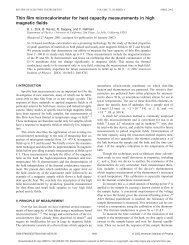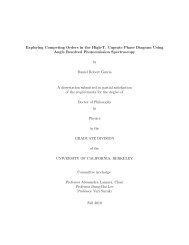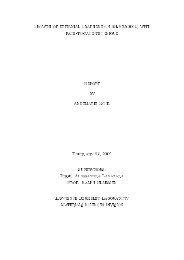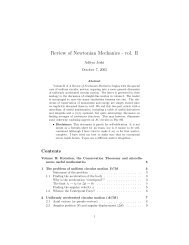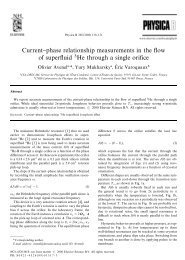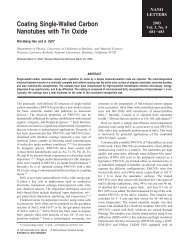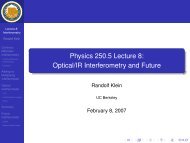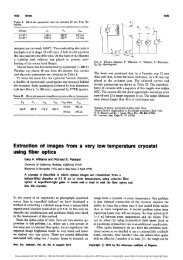Dirac Fermions in Graphene and Graphiteâa view from angle ...
Dirac Fermions in Graphene and Graphiteâa view from angle ...
Dirac Fermions in Graphene and Graphiteâa view from angle ...
Create successful ePaper yourself
Turn your PDF publications into a flip-book with our unique Google optimized e-Paper software.
Figure 6.5. Detailed dispersion near K, which shows that quasiparticles with f<strong>in</strong>ite effective mass <strong>and</strong><br />
defect-<strong>in</strong>duced localized states also contribute to the low energy electronic dynamics. (a) ARPES<br />
<strong>in</strong>tensity map near K (hν=50 eV, k z ≈ 0.08 c ∗ ) along ΓKM ′ direction (blue l<strong>in</strong>e <strong>in</strong> the BZ shown <strong>in</strong><br />
Fig. 6.2(c)). The open circles are the dispersions extracted <strong>from</strong> MDCs. (b) MDCs <strong>from</strong> E F to -50<br />
meV for data <strong>in</strong> panel a. The open circles mark the peaks clearly resolved <strong>in</strong> the data. The <strong>in</strong>set<br />
shows the MDC dispersion <strong>from</strong> -10 to -50 meV, with the parabolic fit used to extract the effective<br />
mass.<br />
(panel c), which is proportional to the two dimensional density of states, barr<strong>in</strong>g the matrix element. In this<br />
energy range, a l<strong>in</strong>ear behavior, similar to what is expected for <strong>Dirac</strong> fermions, is observed. In addition, the<br />
energy <strong>in</strong>tersect is at ≈ 50 meV above E F , <strong>in</strong> agreement with the <strong>Dirac</strong> po<strong>in</strong>t energy extrapolated <strong>from</strong> the<br />
dispersions.<br />
6.2.2 Dispersions at K - massive quasiparticles<br />
The above figures show that near the H po<strong>in</strong>t, the low energy excitations <strong>in</strong> graphite are <strong>Dirac</strong> fermions<br />
characterized by l<strong>in</strong>ear <strong>and</strong> isotropic cone-like dispersion, <strong>in</strong> agreement with transport measurements <strong>in</strong><br />
graphite where <strong>Dirac</strong> fermions are suggested to coexist with quasiparticles which have f<strong>in</strong>ite effective mass 99 .<br />
To ga<strong>in</strong> direct <strong>in</strong>sight on the different types of quasiparticles, ARPES can provide a unique advantage by<br />
directly measur<strong>in</strong>g the effective mass as well as access<strong>in</strong>g its momentum dependence. Fig. 6.5 shows the<br />
<strong>in</strong>tensity map near another high symmetry po<strong>in</strong>t <strong>in</strong> the BZ corner, the K po<strong>in</strong>t. The dispersion (open<br />
circles) shows a parabolic behavior, <strong>in</strong> sharp contrast to the l<strong>in</strong>ear behavior observed near the H po<strong>in</strong>t<br />
(Figs. 6.2 <strong>and</strong> 6.4). This parabolic dispersion po<strong>in</strong>ts to the presence of quasiparticles with f<strong>in</strong>ite effective<br />
mass. To determ<strong>in</strong>e the effective mass, we first extract the low energy dispersion, then fit the MDC <strong>and</strong> EDC<br />
dispersions with a parabolic function. In both cases, the effective mass is determ<strong>in</strong>ed to be 0.069±0.015 m e ,<br />
where m e is the free electron mass. This effective mass measured by ARPES shows some difference with values<br />
reported by transport measurements 112,111,114 , 0.052 <strong>and</strong> 0.038 m e for electrons <strong>and</strong> holes respectively. This<br />
difference may be due to the fact that transport measurements are not momentum selective, <strong>and</strong> therefore<br />
the mass measured is the average mass over all k z values. On the other h<strong>and</strong>, ARPES is momentum selective<br />
<strong>and</strong> the value for the effective mass is for this specific k z value only. Tak<strong>in</strong>g this <strong>in</strong>to account, the agreement<br />
between these measurements is reasonable. In summary, the data presented so far show that the low energy<br />
47






